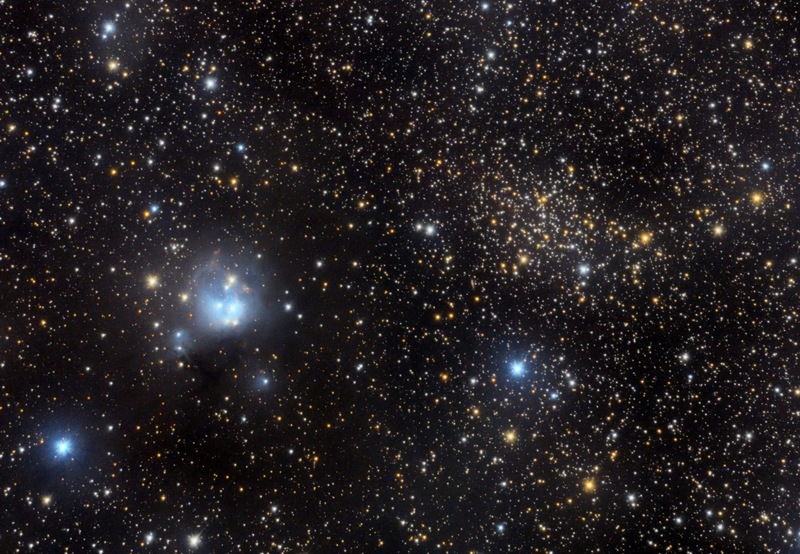NGC7129 and NGC7142
Description
"NGC 7129 is a reflection nebula located 3,300 light years away in the constellation Cepheus. A young open cluster is responsible for illuminating the surrounding nebula.[ A recent survey indicates the cluster contains more than 130 stars less than 1 million years old.[citation needed] NGC 7129 is located just half a degree from nearby cluster NGC 7142.
The nebula is rosebud-shaped; the young stars have blown a large, oddly shaped bubble in the molecular cloud that once surrounded them at their birth. The rosy pink color comes from glowing dust grains on the surface of the bubble being heated by the intense light from the young stars within. The ultra-violet and visible light produced by the young stars is absorbed by the surrounding dust grains. They are heated by this process and release the energy at longer infrared wavelengths as photographed by the Spitzer Space Telescope. The reddish colors in the false-colour infrared image suggest the distribution of hydrocarbon rich molecular material.
The much cooler molecular cloud outside the bubble is mostly invisible to Spitzer. However, three very young stars near the center of the nebula are sending jets of supersonic gas into the cloud. The collision of these jets heats carbon monoxide molecules in the nebula. This produces the complex nebulosity that appears like a stem of a rosebud.
NGC 7142 is located near the reflection nebula NGC 7129, which is a first indication that the cluster may be obscured by an interstellar cloud. Many studies have demonstrated this to be true dating back to the earliest investigations of this cluster. A thorough study of the Cepheus region concluded ""that no part of the field may be considered unobscured.""
Other astronomers have noted that the reddening across the face of this cluster is likely to be uneven. The visibility of several background galaxies in the NW corner of the cluster indicate that the obscuring medium may be lowest here.
Estimates of the amount of reddening range from 0.18 magnitudes, to as high as 0.41 magnitudes."
Equipment and processing
Telescope: Orion 8 inch F5
Mount: Orion Atlas
Camera: ST 8300M
Filters: Baader LRGB
Guiding: PHD
Processing: PixInsight
Capture software: Maxim
Exposures: L: Bin1 25x300, RGB: Bin2 3x300
Location: UACNJ
